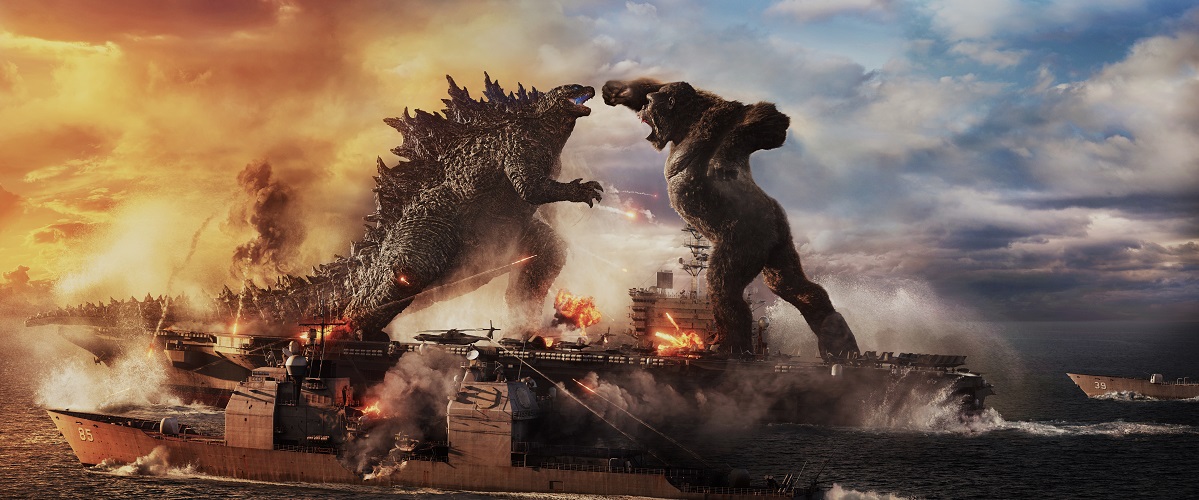
Now streaming on:
"Godzilla vs. Kong" is a crowd-pleasing, smash-'em-up monster flick and a straight-up action picture par excellence. It is a fairy tale and a science-fiction exploration film, a Western, a pro wrestling extravaganza, a conspiracy thriller, a Frankenstein movie, a heartwarming drama about animals and their human pals, and, in spots, a voluptuously wacky spectacle that plays as if the creation sequence in "The Tree of Life" had been subcontracted to the makers of "Yellow Submarine." It has rainstorms and explosions and into-the-wormhole light shows, giant mammals and reptiles and amphibians and insects and beasts that might be hybrids of one or more of the animal kingdoms, with some zombie, robot, or demon thrown in. It dares to dream big and be goofy and sincere as it does it. And yet, for an over-scaled and incident-packed tentpole flick, "Godzilla vs. Kong" stays light on its feet, like its co-leading man, a skyscraper-sized primate who bounds through jungles, tropical and concrete, like an astronaut skipping on the moon. It might be the best studio film so far this year. If it isn't, it's for damn sure the most fun.
Spoilers from here—even though, as I will argue, the tale is told in a way that renders such warnings unnecessary.
Directed by Adam Wingard ("The Guest"), and written by Eric Pearson and Max Borenstein (who wrote the first film in the series), "Godzilla vs. Kong" continues this series' tradition of moving the master narrative about the Monarch project forward while letting each successive team of filmmakers do their own thing. The first entry in the series, "Godzilla," was "Close Encounters of the Kaiju Kind," unveiling its creatures in Steven Spielberg magic-and-wonder mode, and introducing the franchise's unifying premise: giant creatures older than the dinosaurs once lived on the earth's surface, feeding on residual radiation from the Big Bang, then moved inside as that energy ebbed, hibernating in the "Hollow Earth" until humans disturbed their slumber with nuclear testing, strip mining, and the like.
This premise was fused to a philosophy that stayed consistent from film to film. Something like: the kaiju don't hate us. They don't even mean us harm (though they do enjoy a human snack now and then). They're animals jockeying for dominance, over territory and each other. If we hadn't treated Earth like a toilet for centuries, they would've stayed beasts of song and legend, talked about but never seen.
"Godzilla," the Vietnam-era period piece "Kong: Skull Island," and the Calling All Kaiju! extravaganza "Godzilla: King of the Monsters" also established a top secret, international, decades-in-existence organization, the Monarch Project, that linked the films across release years and story decades. (Monarch predates the '70s action of "Skull Island"; it was formed in the 1950s.) Of course all this stuff was modeled on binding elements in the Marvel Cinematic Universe, particularly the the S.H.I.E.L.D.-like agents and scientists of Monarch, and the post-credits scenes revealing the beasts-on-deck. But while some films were more MCU-like than others—the first is the least compromised—the kaiju never devolved into handmaidens of commerce. The most disarming thing about the Monsterverse is its horror, sorrow, and incredulity at the sight of humans dodging extinction-level threats while failing to accept that they can't defeat, reverse or even negotiate with them, only learn to coexist with them. That's why the shots of soldiers and tanks and planes and battleships unloading on these beasts are so absurd. They're cavemen throwing rocks at the sun.
At first, "Godzilla vs. Kong" appears to step back from the tradition of environmental doom-saying and pre-grieving. But those elements turn out to have been sublimated, or submerged, like kaiju, retreating into the earth's core until rude forces bait them to return. A beguiling opening sequence establishes that, following a storm that wiped out Skull Island, King Kong has been moved to a research facility beneath a virtual reality dome that simulates his jungle habitat. He's being studied by anthropological linguist Dr. Ilene Andrews (Rebecca Hall) and her deaf adopted daughter Jia (Kaylee Hottle), sole survivor of the island's Iwi tribe.
Soon after, Godzilla, who hasn't been seen since he killed the three-headed extraterrestrial dragon Ghidorah, attacks the Pensacola, Florida research facility of Apex Cybernetics. Monarch scientist Mark Russell (Kyle Chandler)—father to kaiju-whisperer Madison Russell (Millie Bobby Brown), and former husband of the late renegade Monarch scientist Emma Russell (Vera Farmiga), who turned eco-terrorist in the last film—states that "Godzilla is killing people, and we don't know why." We know. Godzilla is an "apex predator." Like the gladiators in the "Highlander" series, there can be only one. Godzilla is obviously going after Apex (not a name that hides true intent!) because he's threatened by something within the facility. This is a corporation that can create mechanical, um, beings. You could say robots. Or robot monsters. You could even say that Apex could make mecha versions of Godzilla, wink wink.
The filmmakers don't knock themselves out pretending that we can't see where this is headed. The screenplay is front-loaded with cards-on-the-table foreshadowing, including a scene where Apex founder and CEO Walter Simmons (Demián Bichir) convinces Hollow Earth expert Nathan Lind (Alexander Skarsgård) to lead an expedition to the planet's core and help him access a primeval power source that he needs for his, well, project, which will, er, re-establish humanity as the earth's, I suppose you could say, apex predator (cue ominous synthesizer music). So the only remaining pertinent questions are (1) "How soon until Godzilla and Kong fight for the first time?"; (2) "Who will win the first fight, and the rematches?"; and (3) "When will Kong and Godzilla team up?"
The film's "no muss, no fuss" story frees up space to develop relationships—not just between humans, but humans and monsters, and monsters and monsters. The childless Lind, the surrogate parent Andrews, and the orphaned Jia learn to trust each other and work together until they've formed a makeshift nuclear family, like Ripley, Hicks and Newt in "Aliens." Madison bonds with conspiratorial podcaster, muckraker, and Apex investigator Bernie Hayes (Brian Tyree Henry) from afar because he shares her cynical, questing worldview. She trusts his voice and message so implicitly that she embarks on a road trip to find him with help from her friend Josh Valentine (Julian Dennison, unfortunately saddled with the least-necessary character—an exposition-spoonfeeding chatterbox nerd, reminiscent of Bradley Whitford's character in the last movie). Madison lost her brother in one of the first film's kaiju disasters, then lost her mom in "King of the Monsters." By the end of this one, she's acquired a big-brother-like partner in the form of Bernie, and takes a scolding but affectionate quasi-parental tone with Josh (situationally becoming the mom that Maddie was robbed of—by madness, then death).
More consequential and moving, though, are the human/monster and monster/monster relationships. Kong and Jia are a magical screen team, in the tradition of heart-tugging pairings in animal pictures like "The Black Stallion," "Free Willy," and "E.T." The latter resonates extra-hard. The movie treats Kong's heartbeat as a conduit to Jia's mental state, as well as narrative Morse code-pulses for the viewer that reveal Kong's stress level and physical condition. Obviously a lot of the credit for the Kong-Jia friendship should go to the filmmakers, including editor Josh Schaeffer ("Pacific Rim: Uprising"); cinematographer Ben Seresin ("Unstoppable," "Pain and Gain"); and the nation-state of effects artists who did the designs, motion-capturing, rendering, compositing, etc. This a rare modern blockbuster with effects that are truly special. The Hollow Earth scenes in the middle of the picture, especially, are ecstatically dreamy kitsch, in the vein of a '70s sword-and-sorcery paperback book jacket, or a '70s-'80s psychedelic sci-fi or fantasy picture like "Zardoz," "Flash Gordon," "Tron" or "The Neverending Story." The neon primary colors in the Apex labs and Hong Kong streets are blissed-out decadent coolness: John Woo by way of British synthpop videos. Kong and Godzie might as well have done lines of coke off the top of a bus before laying into each other.
And yet, as is increasingly the case, this special effects-laden epic is paradoxically an actor's showcase—and it's scandalous that Terry Notary, who played Kong in this movie and "Skull Island," isn't being credited with the main cast, along with T.J. Storm, who has played Godzilla in three Monsterverse films.
Wingard is on record saying that the physicality of this King Kong is partly modeled on Bruce Willis in the "Die Hard" films and Mel Gibson in the "Lethal Weapon" series. You see the lineage in scenes of Kong dirty-fighting like a back-alley brawler, stumble-running through Hong Kong streets, and jumping off the deck of an aircraft carrier as Godzilla nukes it from below. But this is not just a great stunt-work job. It's according-to-Hoyle, Andy Serkis-caliber acting. Watch Kong cough up seawater after Godzilla almost drowns him, or collapse and doze off after vanquishing an enemy, or tear a winged beast's head from his neck and guzzle blood from the stump like a brigand downing a pint of mead. When Kong awakens after being airlifted to an Antarctic base to start his journey into the Hollow Earth, he has Martin Sheen's still-in-Saigon hangover-face from "Apocalypse Now." When Kong speaks sign language to Jia, looking away and then back at her, you see wheels turning in his mind: I hate what this kid just told me, and it's hard to get my mind around, but I accept it, because I have no choice.
Equally arresting, though more opaque, is Storm's performance as Godzilla. This kaiju is primordial and ruthless, a zaftig brawler with a Charles Barkley caboose. He lacks Kong's grace and ingenuity with weapons, but compensates with ferocity and weight (and dragon breath). Godzilla rages like James Gandolfini in Tony Soprano murder-mode, slamming his bulk into any creature foolish enough to oppose him. He rears back with a glint in his eye before napalm-zapping city blocks. In a succession of bold first-person, shot/reverse shot close-ups, wherein Kong and Godzilla stare into each other's eyes, each trying to intimidate the other, Godzilla projects a mix of curiosity, alpha brutishness, and game-respect-game appreciation for the ape's refusal to submit. The look that Godzilla gives Kong at the end of the picture is Clint Eastwood with scales. The curtain-closing song selection that follows is marvelously counter-intuitive—a needle-drop of joy—but it could also have been Leonard Cohen's "Famous Blue Raincoat": "What can I possibly say?/I guess that I miss you, I guess I forgive you/I’m glad you stood in my way.”
Wingard has joked to interviewers that he wanted his superstar kaiju to kiss—but how much of a joke is that, really? So many action films are about stone-cold badasses meeting cute, punching out their differences, then joining forces to defeat a more urgent threat. Godzilla's steamroller density and Kong's rope-a-dope tactics and jaw-cracking punches evoke (on purpose?) the alleyway fight in the original "48 HRS" that Reggie Hammond and Jack Cates had to get out of their system before teaming up take on Billy Bear and Ganz.
The two-against-one finale pitting Godzilla and Kong against the missile-spraying, jet-propelled, double-footed kangaroo-kicking Mechagodzilla is, like every other action scene in the picture, fully thought out in terms of each fighter's strengths and weaknesses. Not that Mechagodzilla has any. That's what makes him terrifying. He's a Terminator of kaiju. The film even gives him a Skynet moment. He tosses Godzilla around like a child. At one point, poor Godzie gets his head smashed into a vertical-ice-cube-tray office building like Jackie Chan going face-first into a popcorn machine in "Police Story." For a brief, unsettling instant while his cyborg double is thrashing him, a look of dazed insight flashes through his puffy dinosaur eyes. Almost like: What if I deserve this?
How strange and wonderful, though, that after all the ecstatic slapstick ultraviolence, we come away from "Godzilla vs. Kong" recalling not just the mayhem, but the many (comparatively) quiet moments that build out Kong and Godzilla as ... aw ...hell. Might as well say it: as people.
They're lonely, when you think about it, Godzilla and Kong—though neither would admit it. A couple of kings without kingdoms. Godzilla chases one that might not be worth having. Kong never knew he could've had one until this movie—and at the end, what is Kong the king of, really? A jungle full of creatures that look nothing like him. Are there any other primates? Poor Kong was always the only one on Skull Island. We saw the bones of others. Were they killed by beasts? Did they die of natural causes before Kong was born? At least Kong knows now that he's a king by birthright and innate nobility— or that one of his ancestors was. Kong saw that ruined castle. He walked into the grand hall and sat on the throne and held an axe in his fist like Conan. Maybe he imagined dominion over long-gone realms in Hollow Earth. Or maybe he was wondering if Godzilla ever thought: Now what? Godzilla visited Atlantis. Did he rule it? Or did he just surface from time to time, to remind the Atlanteans who was boss? Did he sink the place? If so, does he regret it?
Imagine Godzilla and Kong in a coffee shop, talking about their lives.
Available in theaters and on HBO Max on March 31.
Matt Zoller Seitz is the Editor at Large of RogerEbert.com, TV critic for New York Magazine and Vulture.com, and a finalist for the Pulitzer Prize in criticism.
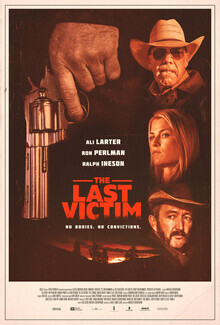
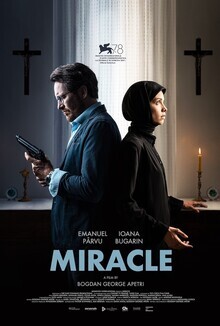
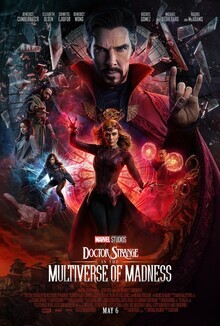
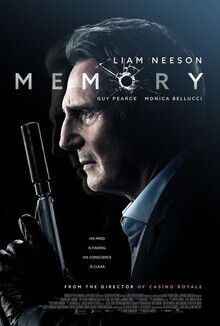
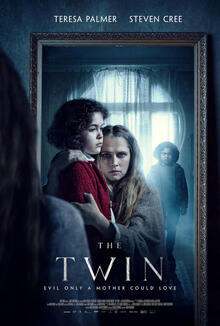
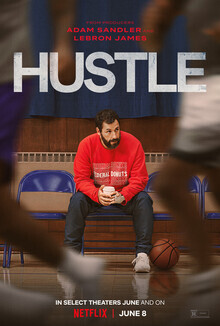
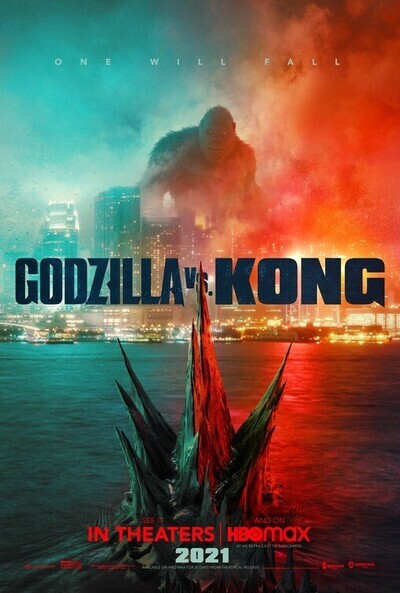
113 minutes
Alexander Skarsgård as Dr. Nathan Lind
Millie Bobby Brown as Madison Russell
Kaylee Hottle as Jia
Rebecca Hall as Dr. Ilene Andrews
Brian Tyree Henry as Bernie Hayes
Shun Oguri as Ren Serizawa
Eiza González as Maia Simmons
Julian Dennison as Josh Valentine
Lance Reddick as Monarch Director
Kyle Chandler as Mark Russell
Demián Bichir as Walter Simmons